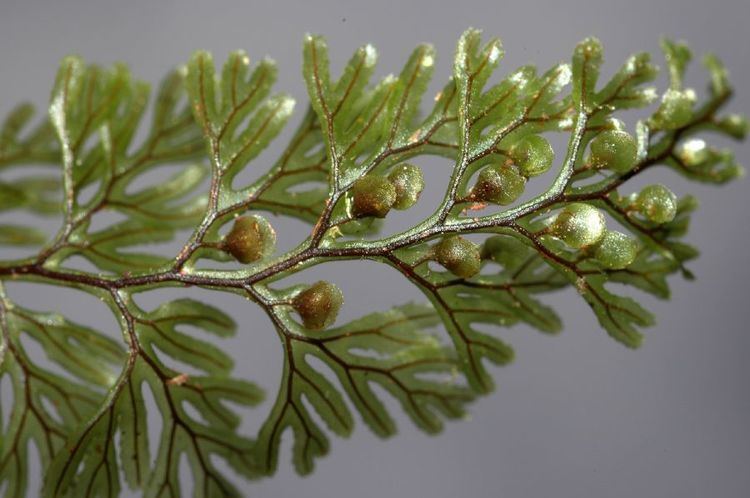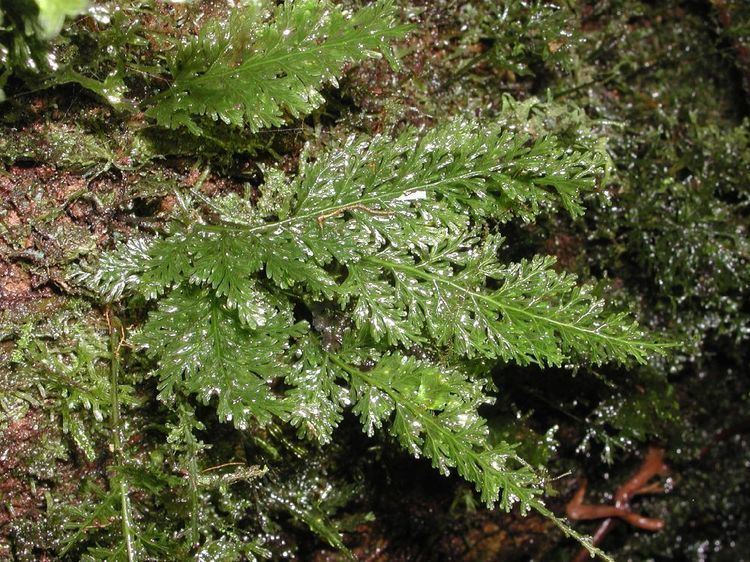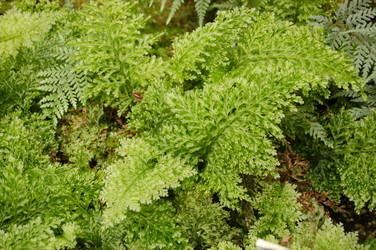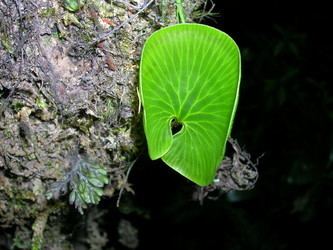Scientific name Hymenophyllaceae Rank Family | Division Pteridophyta Higher classification Hymenophyllales Order Hymenophyllales | |
 | ||
Lower classifications | ||
The Hymenophyllaceae (filmy ferns and bristle ferns) is a family of two to nine genera (depending on classification system) and ca 650 known species of ferns, with a subcosmopolitan distribution, but generally restricted to very damp places or to locations where they are wetted by spray from waterfalls or springs. A recent fossil find shows that ferns of Hymenophyllaceae have existed since at least the Upper Triassic.

The great majority of the species are found in tropical rainforests, but some also occur in temperate rainforests (particularly New Zealand, with 25 species) and slightly drier forest regions. In Europe they are restricted to the Atlantic Ocean fringes of the continent, notably in the Azores, Ireland, and western Great Britain, but one species (Hymenophyllum tunbrigense) locally east to Luxembourg, another (H. wilsonii) so far north as West Norway, Faeroes and South Iceland, while in North America, they are restricted (often occurring solely as gametophytes) to the humid eastern third of the continent and the rainforests of the Pacific Northwest.

They often appear as very dark green or even black clumps and may be mistaken for a robust moss or liverwort. The stem is thin and wiry and the fronds variously pinnate with a single strand ("nerve") of vascular tissue. In most species, the frond, apart from the vascular tissue, is only a single cell thickness, and they do not have any stomata; this makes the plants very susceptible to desiccation where a reliable water supply is not present. The sori are borne at the leaf margins at the end of the nerve. Individual plants may persist for many years.

Classification

In the molecular phylogenetic classification of Smith et al. in 2006, the Hymenophyllales, containing the single family Hymenophyllaceae, were placed in class Polypodiopsida (the leptosporangiate ferns). The linear sequence of Christenhusz et al. (2011), intended for compatibility with the classification of Chase and Reveal (2009) which placed all land plants in Equisetopsida, reclassified Smith's Polypodiopsida as subclass Polypodiidae and placed the Hymenophyllales there. The circumscription of the order and its families was not changed, and that circumscription and placement in Polypodiidae has subsequently been followed in the classifications of Christenhusz and Chase (2014) and PPG I (2016).

Traditionally, only two genera of Hymenophyllaceae have been recognized: (1) Hymenophyllum with bivalved involucres, and (2) Trichomanes with tubular involucres. Subsequent proposals have created 34 genera (Copeland 1938), 6 genera (Morton 1968), 47 genera (Sermolli 1977), and 8 genera (Iwatsuki 1984). But these classifications have all had only limited regional acceptance. Recent molecular phylogenic studies do show two distinct monophyletic clades of fairly equal size, but they are only roughly aligned with the two traditional genera. For example, the traditional Trichomanes subtaxa Pleuromanes and Cardiomanes were shown to belong to the "hymenophylloid" clade. To reflect these recent discoveries Atsushi Ebihara and Kunio Iwatsuki, in 2006, revised the taxonomy of Hymenophyllaceae to place all species of the "hymenophylloid" clade in a single Hymenophyllum genus, and to place the eight clear "trichomanoid" subclades in eight corresponding genera.

This subdivision was recognized by Smith et al. in 2006 and Christenhusz et al. in 2011, but Christenhusz and Chase, in 2014, reverted to combining the trichomanoid clades in Trichomanes. The PPG I classification of 2016 again recognizes the segregate genera, although they are not always accepted by contemporary floras; e.g., as of 2016, Flora of New Zealand prefers to recognize Trichomanes sensu lato due to the difficulty of morphologically distinguishing the segregate genera.
The genera and subgenera assigned by the system of Ebihara et al. are:
